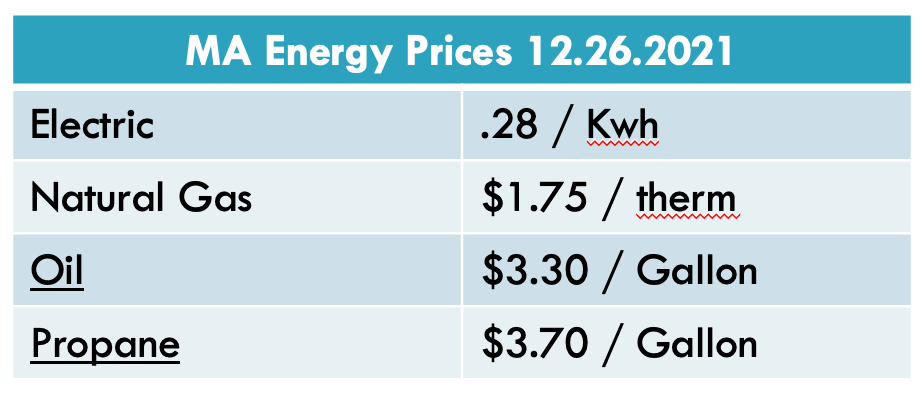
UPDATED: Break Even COP’s for MA
How do you know if you should install a ductless mini-split, or upgrade your air-conditioner to a heat-pump and create a dual-source application during replacement this Winter? I have been asked this countless times over the past few years! I personally always prefer the option of multiple fuel sources, particularly since energy prices have been all over the place during the last decade. Fortunately, using averaged energy prices, there is some simple math to figure out if an aggressive assessment should be made for a dual-source heat pump application, based on equations from ACCA's Manual H: "Heat Pump Systems: Principles and Applications". First, you will need the average energy costs for the selected fuels, and then plug the information into the equations below. This will provide your "break-even COP", or the point where operating the heat pump will cost the same as the other source. You can then take the calculated Coefficient of Performance (COP) and see what temperature the heat pump will be operating at; the lower the better!
I completed a little research for you, so let us insert the recent average prices into the Natural Gas, Oil, and Propane equations to see if the investment in a heat pump will make sense during replacement, or become your primary source of heat – and to what temperature.
As you can see, if installing a 96% Natural Gas furnace, the Break-Even COP would be 3.9. Based on the Heating Performance Data for most Cold Climate Heat Pumps, it would need to be above 40+F outdoors for the cost to operate the heat pump to be cheaper than the Natural Gas Furnace. Keep in mind, just because it is colder than 40F for a short time one day or week, operating natural gas may not save you as much as you think. The majority of the Winter Heating run hours are at this temperature or above across all of New England...only during the really cold 5% of the year would it make complete sense to operate the most efficient natural gas furnace or boiler in this example.
Not all homes in New England are lucky to have access to a Natural Gas supply. There are more than enough Oil Tanks out there to keep the hundreds of delivery companies busy during most New England winters. As you can see in the equation for oil, a resulting break-even COP of 2.6 indicates a significant savings can be realized. Based on installing an extremely efficient 87% oil furnace and the same heat pump performance data, most cold climate heat pumps would still be cheaper to operate as low as 10F. Of course, you must worry about the output of the heat pump at that low ambient, and in order to feel comfortable you will also need to calculate the Thermal Balance Point.
If you decide to install a Propane tank you could realize the same efficiencies as the natural gas furnaces out there, but the increased costs in fuel/delivery is currently higher than oil. The break even COP for installing a heat pump add-on above a 96% Propane Furnace is only .06. This is even lower than the Oil application, resulting in a break-even COP operation of below -15F, proving the recommendation of a more thorough calculation into the Thermal Balance Point and investment costs for going to Dual Source.
With the recent technological advancements in the HVAC industry in controls and conventionally ducted VRF's, break even COP's and Thermal Balance Points can be driven even lower. This makes Sole-Source Heat pump applications more attractive to New England homeowners, despite recent electric rate hikes. If they live in a Municipal electric town, rates are lower and heat pumps could be even more cost effective. Some contractors are still installing electric supplemental heat, hopefully in stages, for low-ambient operation. Although not more efficient than the heat strips they replace, the new heat pumps could save more than enough above the temperature of any defrost cycle to still be worth it, with some models getting 100% capacity down to -5F!